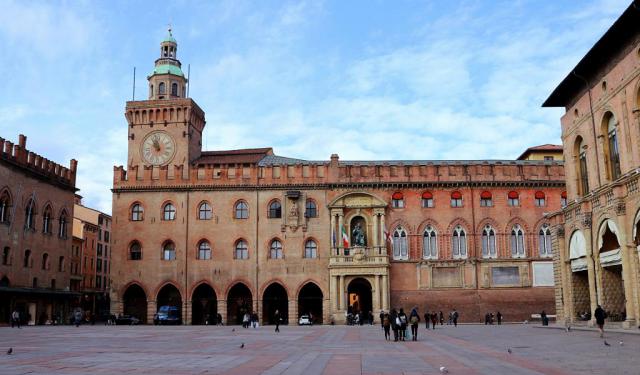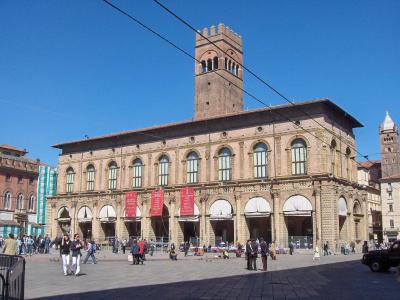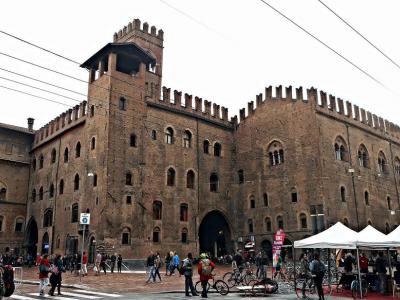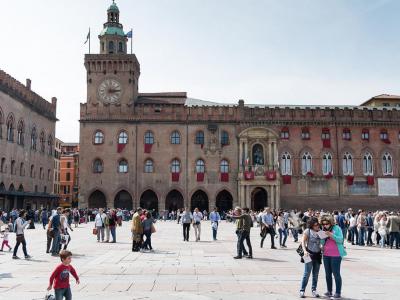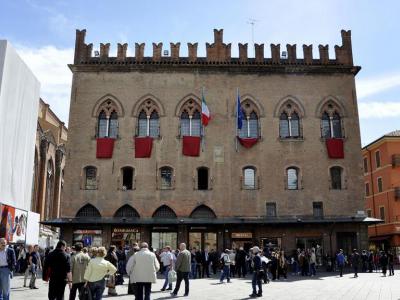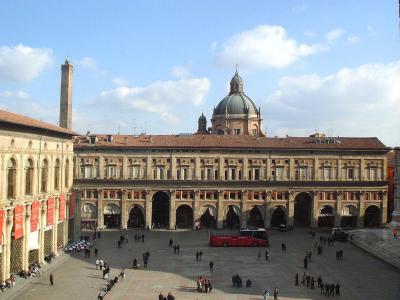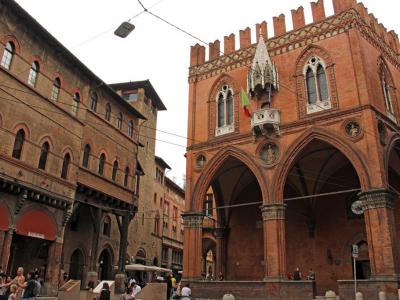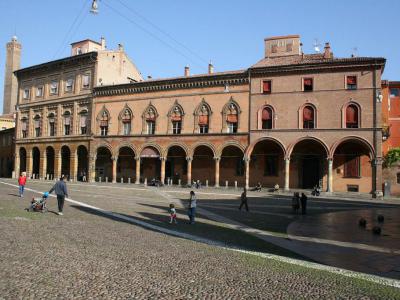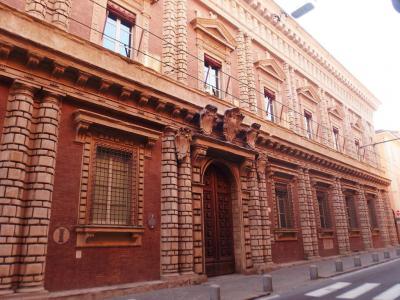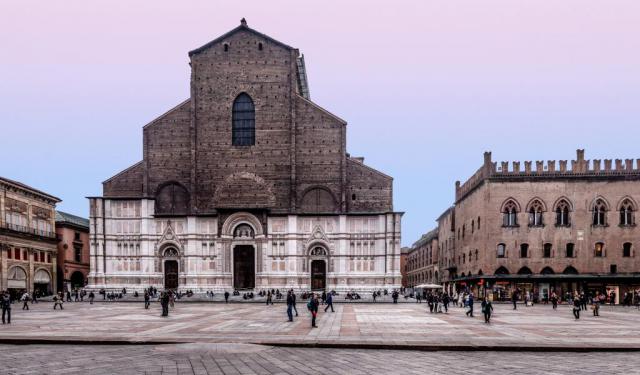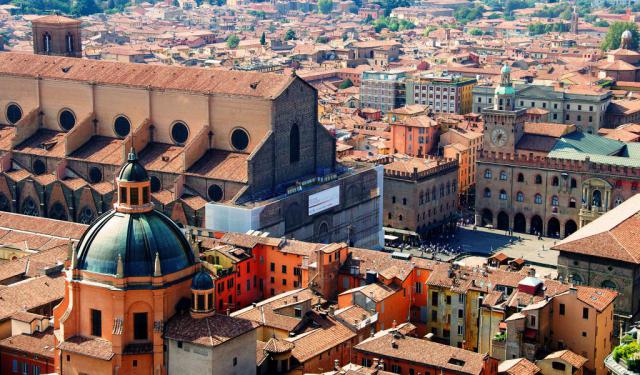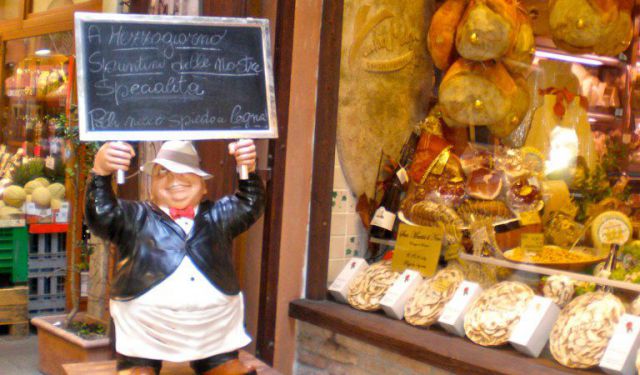Bologna Palaces (Self Guided), Bologna
Bologna is famous for a huge number of ancient buildings and unique historic sites, closely associated with a huge number of mysteries and legends. There are numerous incredibly beautiful palaces in the city, richly adorned with art by great masters, intricately decorated interiors and luxurious old furniture. Each palace is fit to leave an unforgettable impression upon visitors, firmly imprinted in their memory with a feel of an elusive spirit of the times.
Among them mandatory to visit, perhaps, is Palazzo del Podestà, a historic landmark erected circa 1200 as the seat of local government.
Also notable are:
Palazzo Re Enzo – built between 1244 and 1246 as an extension of the nearby Palazzo del Podestà; takes its name from King Enzio of Sardinia, Frederick II's son, who was a prisoner here.
Palazzo d'Accursio – formerly a Town Hall of Bologna; now home to the Civic Art Collection.
Palazzo dei Notai – built in 1287 by the city's notaries guild as their seat, redesigned in 1381.
Palazzo dei Banchi – a 16th century Renaissance-style palace, presently occupied by businesses offices and private apartments.
Palazzo Della Mercanzia – a Gothic palace built in 1382; inside there is a library storing original recipes of some of the classic regional cuisine, such as Bolognese sauce and green lasagna.
Palazzo Bolognini – a piece of Renaissance architecture erected between 1517–25; still owned by descendant of the 16th-century Senatorial family.
Palazzo Fantuzzi – a monumental Renaissance-style palace designed in 1517; known for its sculpted exterior decoration and beautiful ceilings inside.
To visit and learn more about these magnificent palaces of Bologna, take our self-guided walking tour and enjoy!
Among them mandatory to visit, perhaps, is Palazzo del Podestà, a historic landmark erected circa 1200 as the seat of local government.
Also notable are:
Palazzo Re Enzo – built between 1244 and 1246 as an extension of the nearby Palazzo del Podestà; takes its name from King Enzio of Sardinia, Frederick II's son, who was a prisoner here.
Palazzo d'Accursio – formerly a Town Hall of Bologna; now home to the Civic Art Collection.
Palazzo dei Notai – built in 1287 by the city's notaries guild as their seat, redesigned in 1381.
Palazzo dei Banchi – a 16th century Renaissance-style palace, presently occupied by businesses offices and private apartments.
Palazzo Della Mercanzia – a Gothic palace built in 1382; inside there is a library storing original recipes of some of the classic regional cuisine, such as Bolognese sauce and green lasagna.
Palazzo Bolognini – a piece of Renaissance architecture erected between 1517–25; still owned by descendant of the 16th-century Senatorial family.
Palazzo Fantuzzi – a monumental Renaissance-style palace designed in 1517; known for its sculpted exterior decoration and beautiful ceilings inside.
To visit and learn more about these magnificent palaces of Bologna, take our self-guided walking tour and enjoy!
How it works: Download the app "GPSmyCity: Walks in 1K+ Cities" from Apple App Store or Google Play Store to your mobile phone or tablet. The app turns your mobile device into a personal tour guide and its built-in GPS navigation functions guide you from one tour stop to next. The app works offline, so no data plan is needed when traveling abroad.
Bologna Palaces Map
Guide Name: Bologna Palaces
Guide Location: Italy » Bologna (See other walking tours in Bologna)
Guide Type: Self-guided Walking Tour (Sightseeing)
# of Attractions: 8
Tour Duration: 1 Hour(s)
Travel Distance: 1.4 Km or 0.9 Miles
Author: vickyc
Sight(s) Featured in This Guide:
Guide Location: Italy » Bologna (See other walking tours in Bologna)
Guide Type: Self-guided Walking Tour (Sightseeing)
# of Attractions: 8
Tour Duration: 1 Hour(s)
Travel Distance: 1.4 Km or 0.9 Miles
Author: vickyc
Sight(s) Featured in This Guide:
- Palazzo del Podesta (Podesta Palace)
- Palazzo Re Enzo (King Enzo Palace)
- Palazzo d'Accursio (Municipal Palace)
- Palazzo dei Notai (Notaries' Palace)
- Palazzo dei Banchi (Palace of the Banks)
- Palazzo della Mercanzia (Merchants' Palace)
- Palazzo Bolognini (Bolognini Palace)
- Palazzo Fantuzzi (Fantuzzi Palace)
1) Palazzo del Podesta (Podesta Palace)
Facing the Main Square ("Piazza Maggiore") stands the elegant Podestà Palace (accessible only during special exhibitions), erected in the 13th century as the epicenter of political power. Alas, it quickly became evident that the place was too small for the business of governance, prompting the birth of the neighboring King Enzo Palace ("Palazzo Re Enzo").
The Podesta Palace features a Renaissance porticoed facade (replacing the original Gothic one) facing the Main Square and is distinguished by its brick tower, the Torre dell'Arengo, originally erected to summon citizens in emergencies. Architecture enthusiasts should take note of the pillars of the portico, carved with a whopping 3,000 rosettes, each one as unique as a snowflake in a blizzard!
Beneath the vault, known as the Voltone del Podesta, terracotta statues of the town’s patron saints were once displayed. Today, visitors are drawn to the echo in the 'whispering gallery' – stand at one of the four corners of the arcade, whisper sweet nothings, and your voice will softly reverberate from the opposite corner. It's like having a secret conversation with yourself!
The Podesta Palace features a Renaissance porticoed facade (replacing the original Gothic one) facing the Main Square and is distinguished by its brick tower, the Torre dell'Arengo, originally erected to summon citizens in emergencies. Architecture enthusiasts should take note of the pillars of the portico, carved with a whopping 3,000 rosettes, each one as unique as a snowflake in a blizzard!
Beneath the vault, known as the Voltone del Podesta, terracotta statues of the town’s patron saints were once displayed. Today, visitors are drawn to the echo in the 'whispering gallery' – stand at one of the four corners of the arcade, whisper sweet nothings, and your voice will softly reverberate from the opposite corner. It's like having a secret conversation with yourself!
2) Palazzo Re Enzo (King Enzo Palace)
The King Enzo Palace (accessible only during exhibitions), sporting its current Gothic makeover from the 1905 renovation, carries the legacy of its namesake, Enzo, the "King of Sardinia", son of Emperor Frederick II. After a less-than-stellar performance at the Battle of Fossalta in 1249, Enzo found himself locked up here for 23 years until his demise in 1272. Legend has it that by day, he strolled freely through the palace halls, but come nightfall, he was left dangling in a cage from the ceiling. And yes, there's even a spicy tale of Enzo's romantic escapades, with whispers of illegitimate offspring and clandestine love affairs. Apparently, his supposed son, Bentivoglio, sprouted from a liaison with a peasant woman, thus sowing the seeds for the Bentivoglio dynasty that ruled Bologna later on.
Adjacent to this historic hotspot, in the lively square bearing his name, stands the Fountain of Neptune ("Fontana del Nettuno"), crafted by Giambologna in 1556. Born Jean Boulogne in Flanders, this sculptor found his creative groove in Florence; however, it was his aquatic masterpiece in Bologna that truly made waves. Featuring a colossal Neptune (dubbed 'Il Gigante'), flanked by cherubs and four voluptuous sirens astride dolphins spouting water from, well, unconventional sources, this fountain was a cheeky thumbing of the nose at papal sensibilities. Initially causing quite the uproar with its nudity, the statue was later deemed too hot for censorship, much to the delight of the locals who relish in pointing out the most strategic viewpoints for admiring Neptune's, ahem, imposing stature.
Adjacent to this historic hotspot, in the lively square bearing his name, stands the Fountain of Neptune ("Fontana del Nettuno"), crafted by Giambologna in 1556. Born Jean Boulogne in Flanders, this sculptor found his creative groove in Florence; however, it was his aquatic masterpiece in Bologna that truly made waves. Featuring a colossal Neptune (dubbed 'Il Gigante'), flanked by cherubs and four voluptuous sirens astride dolphins spouting water from, well, unconventional sources, this fountain was a cheeky thumbing of the nose at papal sensibilities. Initially causing quite the uproar with its nudity, the statue was later deemed too hot for censorship, much to the delight of the locals who relish in pointing out the most strategic viewpoints for admiring Neptune's, ahem, imposing stature.
3) Palazzo d'Accursio (Municipal Palace)
The grand structure towering over the western side of the Main Square ("Piazza Maggiore") is the Palazzo d'Accursio, also known as the Municipal Palace for having served as the city's Town Hall until 2008. Dating back to the 13th century, it was originally the residence of the renowned medieval lawyer, Accursius. Subsequently acquired by the city, the structure was extensively renovated as a symbol of papal authority. In 1530, just two days before his coronation as Emperor in the Basilica of Saint Petronius, Charles V was crowned King of Italy in the palace's chapel, where he received the Iron Cross of Lombardy. A temporary passageway was specially constructed for this event, connecting the palace to the Saint Petronius basilica across the Main Square.
Above the portal of the palace is a monumental bronze statue (1580) depicting Pope Gregory XIII, the Bolognese pope credited with reforming the old Roman calendar and introducing the Gregorian calendar still in use today. Positioned above and to the left of the entrance is a striking terracotta sculpture of the "Virgin and Child" (1478) crafted by the Italian sculptor Niccolò dell'Arca. Upon crossing the courtyard and ascending the splendid, corded staircases, visitors are greeted by frescoed interiors on the first and second floors. Remodeled by papal legates in the 16th century, these ceremonial halls offer fine views of the square. The Red Room ("Sala Rossa"), adorned with immense chandeliers, is a popular setting for civil ceremonies.
The numerous chambers of the Municipal Art Collections housed at the top of the palace exhibit Emilian artworks spanning from the 13th to 19th centuries. A visit there provides insight into the decor, furnishings, and artistic preferences during the era of papal governance.
Above the portal of the palace is a monumental bronze statue (1580) depicting Pope Gregory XIII, the Bolognese pope credited with reforming the old Roman calendar and introducing the Gregorian calendar still in use today. Positioned above and to the left of the entrance is a striking terracotta sculpture of the "Virgin and Child" (1478) crafted by the Italian sculptor Niccolò dell'Arca. Upon crossing the courtyard and ascending the splendid, corded staircases, visitors are greeted by frescoed interiors on the first and second floors. Remodeled by papal legates in the 16th century, these ceremonial halls offer fine views of the square. The Red Room ("Sala Rossa"), adorned with immense chandeliers, is a popular setting for civil ceremonies.
The numerous chambers of the Municipal Art Collections housed at the top of the palace exhibit Emilian artworks spanning from the 13th to 19th centuries. A visit there provides insight into the decor, furnishings, and artistic preferences during the era of papal governance.
4) Palazzo dei Notai (Notaries' Palace)
Sitting at the heart of the city, this palace stands as a testament to the historical richness that defines the Main Square ("Piazza Maggiore"), which draws visitors from across Italy and beyond. Originating from the 13th century, its majestic presence today owes much to a restoration carried out in the early 20th century, rejuvenating its medieval charm.
True to its name, the Palace once played host to the Society of Bolognese Notaries, a group of scribes wielding quills like swords in their noble quest for paperwork domination. Its facade proudly flaunts their coat of arms – three inkwells and as many quills – a nod to their ink-stained legacy. In a bygone era, during the 18th century, the ground floor housed the so-called "salara", or salt deposit.
Within the halls of the palace, glimpses of history are captured in 15th-century frescoes, alongside several municipal offices. The main (second) floor hosts a myriad of events and initiatives orchestrated by the Municipality of Bologna within the grand Sala dei Notai.
True to its name, the Palace once played host to the Society of Bolognese Notaries, a group of scribes wielding quills like swords in their noble quest for paperwork domination. Its facade proudly flaunts their coat of arms – three inkwells and as many quills – a nod to their ink-stained legacy. In a bygone era, during the 18th century, the ground floor housed the so-called "salara", or salt deposit.
Within the halls of the palace, glimpses of history are captured in 15th-century frescoes, alongside several municipal offices. The main (second) floor hosts a myriad of events and initiatives orchestrated by the Municipality of Bologna within the grand Sala dei Notai.
5) Palazzo dei Banchi (Palace of the Banks)
The final structure erected in the Main Square ("Piazza Maggiore") was the Palace of the Banks. Designed by Vignola, one of the great Italian architects of the 16th century, its spectacular frontage was strategically designed to obscure the alleyways of the rear market, earning its title from the historic presence of currency exchange institutions.
Featuring an asymmetrical façade with 15 rounded arches, flanked by grand Corinthian pilasters, the palace is further distinguished by its Mannerist arrangement of windows, creating the illusion of a cohesive gallery within a singular palace structure. Linking the edifice is a portico, referred to as a "pavaglione" (pavilion), to the Archiginnasio of Bologna, a prominent establishment of the University of Bologna.
As of 2015, behind the palace, intermittently, lies an open-air market showcasing local produce, while the interior accommodates a mix of commercial enterprises and residential units. Adjacent stands the city's Archaeological Museum and the Church of Santa Maria della Vita.
Featuring an asymmetrical façade with 15 rounded arches, flanked by grand Corinthian pilasters, the palace is further distinguished by its Mannerist arrangement of windows, creating the illusion of a cohesive gallery within a singular palace structure. Linking the edifice is a portico, referred to as a "pavaglione" (pavilion), to the Archiginnasio of Bologna, a prominent establishment of the University of Bologna.
As of 2015, behind the palace, intermittently, lies an open-air market showcasing local produce, while the interior accommodates a mix of commercial enterprises and residential units. Adjacent stands the city's Archaeological Museum and the Church of Santa Maria della Vita.
6) Palazzo della Mercanzia (Merchants' Palace)
The heart of Bologna's commercial hub since medieval times, Merchants' Square ("Piazza della Mercanzia") is presided over by the crenelated Merchants' Palace, formerly the hub of merchants' trade and customs activities, now housing the Chamber of Commerce. Its Gothic facade is embellished with statues representing the city's patron saints, overseeing an economy once driven by gold, textiles, silk, and hemp, now marked by local success stories like the luxurious La Perla lingerie and hemp-free Bruno Magli shoes.
Within its walls, the palace safeguards the original recipes of local delicacies, including the authentic Bolognese sauce for tagliatelle al ragù. (For a taste, Pappagallo, nestled in a charming 13th-century building on the square, offers an excellent dining experience.) Additionally, visitors to can explore paintings of the Chamber of Commerce presidents on the second floor, alongside Renaissance-style frescoes, walls decked out in luxurious silk fabric, a dazzling Murano chandelier, and a quaint courtyard.
Within its walls, the palace safeguards the original recipes of local delicacies, including the authentic Bolognese sauce for tagliatelle al ragù. (For a taste, Pappagallo, nestled in a charming 13th-century building on the square, offers an excellent dining experience.) Additionally, visitors to can explore paintings of the Chamber of Commerce presidents on the second floor, alongside Renaissance-style frescoes, walls decked out in luxurious silk fabric, a dazzling Murano chandelier, and a quaint courtyard.
7) Palazzo Bolognini (Bolognini Palace)
The senatorial palace in Piazza Santo Stefano exemplifies the refined taste of the Bolognese Renaissance. Its construction began in 1517, yet due to various reasons, the building process faced interruptions and it wasn't until 1884 that the final version was completed. The entire facade is covered with intricate terracotta busts, protruding from circular niches, sparking the curiosity of passersby. One can spot a diverse array of figures including ladies, warriors, gods, and notably, a demon or possibly a satyr, positioned prominently at the center. While the rationale behind this placement remains unclear, similar demonic faces can be observed on other buildings around town.
Since the 1800s, the palace has been home to various occupants, with one of the most notable being the Society of the Nobles' Casino, which held residence on the first floor from 1823 to 1855. The club organized performances by renowned composers such as Donizetti, Haydn, and Rossini, whose opera "William Tell", staged in 1836 during Lent, caused a significant commotion with the authorities and police. Over the years, the noble floor also hosted the Monarchist People's Club, the Fighters' Circle, the Royal Corps of Civil Engineering, and the British Council until 1990. Not to forget that the ground floor has been occupied since 1916 by the Gas Company, the Gas Lighting Company, and the Pezzoli Company, specializing in wine instruments, which continues to operate there to this day.
Since the 1800s, the palace has been home to various occupants, with one of the most notable being the Society of the Nobles' Casino, which held residence on the first floor from 1823 to 1855. The club organized performances by renowned composers such as Donizetti, Haydn, and Rossini, whose opera "William Tell", staged in 1836 during Lent, caused a significant commotion with the authorities and police. Over the years, the noble floor also hosted the Monarchist People's Club, the Fighters' Circle, the Royal Corps of Civil Engineering, and the British Council until 1990. Not to forget that the ground floor has been occupied since 1916 by the Gas Company, the Gas Lighting Company, and the Pezzoli Company, specializing in wine instruments, which continues to operate there to this day.
8) Palazzo Fantuzzi (Fantuzzi Palace)
Built in 1517 on the grounds of former medieval dwellings, this structure – now partly dedicated to exhibitions – once served as the residence of the esteemed Fantuzzi family, prominent members of the Bolognese Senate. Its striking facade harkens back to the Tosco-Roman architectural tradition of the 16th century, embellished with depictions of elephants, alluding to the Fantuzzis' heraldic emblem.
Construction reached its completion in 1680, coinciding with the election of Carlo Ridolfo Fantuzzi as Gonfalonier. In a gesture of self-celebration, he commissioned the installation of a new staircase within the palace, leading guests to the grand ballroom on the noble floor. Crafted by Pietro Canali, the celebrated staircase is adorned with statues depicting Hercules and Atlas.
Visitors to the second floor have the opportunity to explore the magnificent hall, adorned with frescoes crafted by Francesco Galli Bibiena between 1678 and 1684. Departing from conventional frontal perspectives, Bibiena pioneered a new approach to architectural painting, employing corner perspectives. On the wall is a simulated asymmetrical open gallery populated by deities and mythological beings. Bibiena's mastery in figure painting, enhanced by cleverly painted colonnades and wings, creates an illusion of expanded space, captivating and deceiving the viewer. Opposite the windows, a painted verdant garden provides a theatrical backdrop, offering glimpses into imaginative landscapes. Noteworthy artists such as Angelo Michele Colonna, known for his contributions to the Royal Palace of Madrid and the Palace of Versailles, also contributed to the frescoes decorating other rooms within the palace.
Construction reached its completion in 1680, coinciding with the election of Carlo Ridolfo Fantuzzi as Gonfalonier. In a gesture of self-celebration, he commissioned the installation of a new staircase within the palace, leading guests to the grand ballroom on the noble floor. Crafted by Pietro Canali, the celebrated staircase is adorned with statues depicting Hercules and Atlas.
Visitors to the second floor have the opportunity to explore the magnificent hall, adorned with frescoes crafted by Francesco Galli Bibiena between 1678 and 1684. Departing from conventional frontal perspectives, Bibiena pioneered a new approach to architectural painting, employing corner perspectives. On the wall is a simulated asymmetrical open gallery populated by deities and mythological beings. Bibiena's mastery in figure painting, enhanced by cleverly painted colonnades and wings, creates an illusion of expanded space, captivating and deceiving the viewer. Opposite the windows, a painted verdant garden provides a theatrical backdrop, offering glimpses into imaginative landscapes. Noteworthy artists such as Angelo Michele Colonna, known for his contributions to the Royal Palace of Madrid and the Palace of Versailles, also contributed to the frescoes decorating other rooms within the palace.
Walking Tours in Bologna, Italy
Create Your Own Walk in Bologna
Creating your own self-guided walk in Bologna is easy and fun. Choose the city attractions that you want to see and a walk route map will be created just for you. You can even set your hotel as the start point of the walk.
Historical Churches
The historic city of Bologna is one of the most sumptuous medieval places in Italy, as well as one of the country's most visited destinations. There are churches everywhere in the city, many of which are well-preserved and well worth a visit. Magnificent and centuries-old, each of them has its own specialty and history carved into, replete with great historic artifacts associated with world... view more
Tour Duration: 1 Hour(s)
Travel Distance: 2.2 Km or 1.4 Miles
Tour Duration: 1 Hour(s)
Travel Distance: 2.2 Km or 1.4 Miles
Bologna Introduction Walking Tour
Bologna is the Emilia-Romagna region's capital. This large northern city is the seventh most populous city in Italy and has been a vital cultural center for millennia.
Archeological discoveries indicate the area has been settled since the third millennium BC. First, the Etruscans settled the area, then the Celts, and then the Romans. During the Middle Ages, Bologna was a free municipality... view more
Tour Duration: 2 Hour(s)
Travel Distance: 2.3 Km or 1.4 Miles
Archeological discoveries indicate the area has been settled since the third millennium BC. First, the Etruscans settled the area, then the Celts, and then the Romans. During the Middle Ages, Bologna was a free municipality... view more
Tour Duration: 2 Hour(s)
Travel Distance: 2.3 Km or 1.4 Miles
Bologna's Shopping Areas
When it comes to shopping, Bologna walks tall amid grands like Milan or Rome, with a harmonious mix of international chains, exclusive boutiques, luxury stores and open-air markets lining the streets in the city center, offering a wealth of international fashion, designer brands and top quality local delicacies in rich supply.
Shopping here is particularly pleasant on weekends when Zone... view more
Tour Duration: 1 Hour(s)
Travel Distance: 0.8 Km or 0.5 Miles
Shopping here is particularly pleasant on weekends when Zone... view more
Tour Duration: 1 Hour(s)
Travel Distance: 0.8 Km or 0.5 Miles
The Most Popular Cities
/ view all
